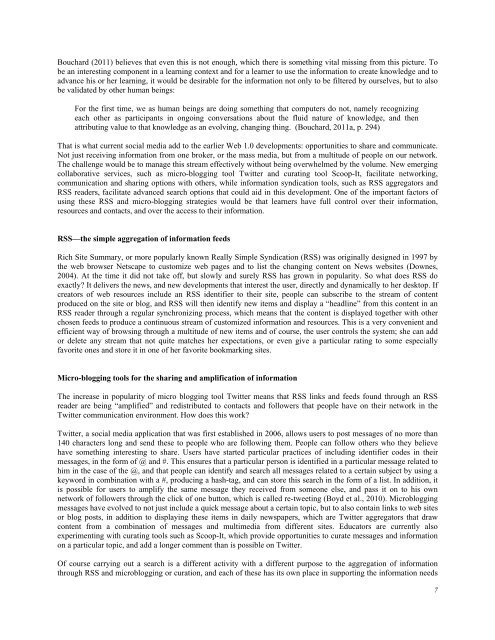April 2012 Volume 15 Number 2 - Educational Technology & Society
April 2012 Volume 15 Number 2 - Educational Technology & Society
April 2012 Volume 15 Number 2 - Educational Technology & Society
You also want an ePaper? Increase the reach of your titles
YUMPU automatically turns print PDFs into web optimized ePapers that Google loves.
Bouchard (2011) believes that even this is not enough, which there is something vital missing from this picture. To<br />
be an interesting component in a learning context and for a learner to use the information to create knowledge and to<br />
advance his or her learning, it would be desirable for the information not only to be filtered by ourselves, but to also<br />
be validated by other human beings:<br />
For the first time, we as human beings are doing something that computers do not, namely recognizing<br />
each other as participants in ongoing conversations about the fluid nature of knowledge, and then<br />
attributing value to that knowledge as an evolving, changing thing. (Bouchard, 2011a, p. 294)<br />
That is what current social media add to the earlier Web 1.0 developments: opportunities to share and communicate.<br />
Not just receiving information from one broker, or the mass media, but from a multitude of people on our network.<br />
The challenge would be to manage this stream effectively without being overwhelmed by the volume. New emerging<br />
collaborative services, such as micro-blogging tool Twitter and curating tool Scoop-It, facilitate networking,<br />
communication and sharing options with others, while information syndication tools, such as RSS aggregators and<br />
RSS readers, facilitate advanced search options that could aid in this development. One of the important factors of<br />
using these RSS and micro-blogging strategies would be that learners have full control over their information,<br />
resources and contacts, and over the access to their information.<br />
RSS—the simple aggregation of information feeds<br />
Rich Site Summary, or more popularly known Really Simple Syndication (RSS) was originally designed in 1997 by<br />
the web browser Netscape to customize web pages and to list the changing content on News websites (Downes,<br />
2004). At the time it did not take off, but slowly and surely RSS has grown in popularity. So what does RSS do<br />
exactly? It delivers the news, and new developments that interest the user, directly and dynamically to her desktop. If<br />
creators of web resources include an RSS identifier to their site, people can subscribe to the stream of content<br />
produced on the site or blog, and RSS will then identify new items and display a “headline” from this content in an<br />
RSS reader through a regular synchronizing process, which means that the content is displayed together with other<br />
chosen feeds to produce a continuous stream of customized information and resources. This is a very convenient and<br />
efficient way of browsing through a multitude of new items and of course, the user controls the system; she can add<br />
or delete any stream that not quite matches her expectations, or even give a particular rating to some especially<br />
favorite ones and store it in one of her favorite bookmarking sites.<br />
Micro-blogging tools for the sharing and amplification of information<br />
The increase in popularity of micro blogging tool Twitter means that RSS links and feeds found through an RSS<br />
reader are being “amplified” and redistributed to contacts and followers that people have on their network in the<br />
Twitter communication environment. How does this work?<br />
Twitter, a social media application that was first established in 2006, allows users to post messages of no more than<br />
140 characters long and send these to people who are following them. People can follow others who they believe<br />
have something interesting to share. Users have started particular practices of including identifier codes in their<br />
messages, in the form of @ and #. This ensures that a particular person is identified in a particular message related to<br />
him in the case of the @, and that people can identify and search all messages related to a certain subject by using a<br />
keyword in combination with a #, producing a hash-tag, and can store this search in the form of a list. In addition, it<br />
is possible for users to amplify the same message they received from someone else, and pass it on to his own<br />
network of followers through the click of one button, which is called re-tweeting (Boyd et al., 2010). Microblogging<br />
messages have evolved to not just include a quick message about a certain topic, but to also contain links to web sites<br />
or blog posts, in addition to displaying these items in daily newspapers, which are Twitter aggregators that draw<br />
content from a combination of messages and multimedia from different sites. Educators are currently also<br />
experimenting with curating tools such as Scoop-It, which provide opportunities to curate messages and information<br />
on a particular topic, and add a longer comment than is possible on Twitter.<br />
Of course carrying out a search is a different activity with a different purpose to the aggregation of information<br />
through RSS and microblogging or curation, and each of these has its own place in supporting the information needs<br />
7

















